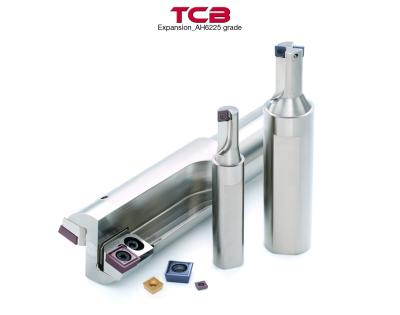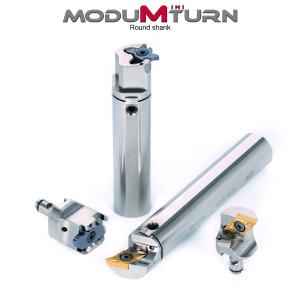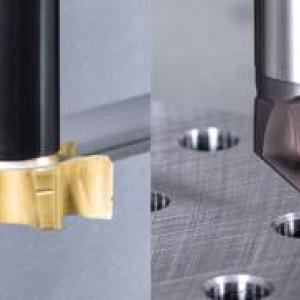Contact Details

Tungaloy has added AH6225 grade inserts to its TCB indexable counterboring tool line.
TCB is an indexable multifunctional counterboring tool line that is designed to be used on a variety of turning machines from traditional lathes to the latest cnc machining centers. The tool bodies are available for cutting diameters from 10 millimeters (.394 inches) to 59 millimeters (2.323 inches), allowing a range of counterbore diameters for cap bolts and nuts, as well as the expansions of existing hole diameters. The cutter bodies come in two styles depending on the intended cutting diameters: a mono block style is designed for machining from 10 to 43 millimeter diameter bores, while the cutters with exchangeable cartridges are for 26 (1.024) to 59 millimeter (2.323 inch) diameters. The exchangeable cartridges can fine-adjust the cutting diameters in 0.1 millimeter (.004 inch) increments simply by placing the adjusting shim plates, which are sold separately, between the cartridge and the pocket.
TCB now offers AH6225 grade inserts. This latest physical vapor deposition (PVD) coated grade features a high-hardness titanium-rich PVD coating, combined with a tough dedicated carbide substrate. Extremely reliable and versatile insert grade, AH6225 allows TCB to efficiently cut bores in all material groups, including steel, stainless steel, and exotic materials.
Related Glossary Terms
- centers
centers
Cone-shaped pins that support a workpiece by one or two ends during machining. The centers fit into holes drilled in the workpiece ends. Centers that turn with the workpiece are called “live” centers; those that do not are called “dead” centers.
- computer numerical control ( CNC)
computer numerical control ( CNC)
Microprocessor-based controller dedicated to a machine tool that permits the creation or modification of parts. Programmed numerical control activates the machine’s servos and spindle drives and controls the various machining operations. See DNC, direct numerical control; NC, numerical control.
- counterbore
counterbore
Tool, guided by a pilot, that expands a hole to a certain depth.
- counterboring
counterboring
Enlarging one end of a drilled hole. The enlarged hole, which is concentric with the original hole, is flat on the bottom. Counterboring is used primarily to set bolt heads and nuts below the workpiece surface.
- physical vapor deposition ( PVD)
physical vapor deposition ( PVD)
Tool-coating process performed at low temperature (500° C), compared to chemical vapor deposition (1,000° C). Employs electric field to generate necessary heat for depositing coating on a tool’s surface. See CVD, chemical vapor deposition.
- physical vapor deposition ( PVD)2
physical vapor deposition ( PVD)
Tool-coating process performed at low temperature (500° C), compared to chemical vapor deposition (1,000° C). Employs electric field to generate necessary heat for depositing coating on a tool’s surface. See CVD, chemical vapor deposition.
- turning
turning
Workpiece is held in a chuck, mounted on a face plate or secured between centers and rotated while a cutting tool, normally a single-point tool, is fed into it along its periphery or across its end or face. Takes the form of straight turning (cutting along the periphery of the workpiece); taper turning (creating a taper); step turning (turning different-size diameters on the same work); chamfering (beveling an edge or shoulder); facing (cutting on an end); turning threads (usually external but can be internal); roughing (high-volume metal removal); and finishing (final light cuts). Performed on lathes, turning centers, chucking machines, automatic screw machines and similar machines.











 PRODUCTS
PRODUCTS

